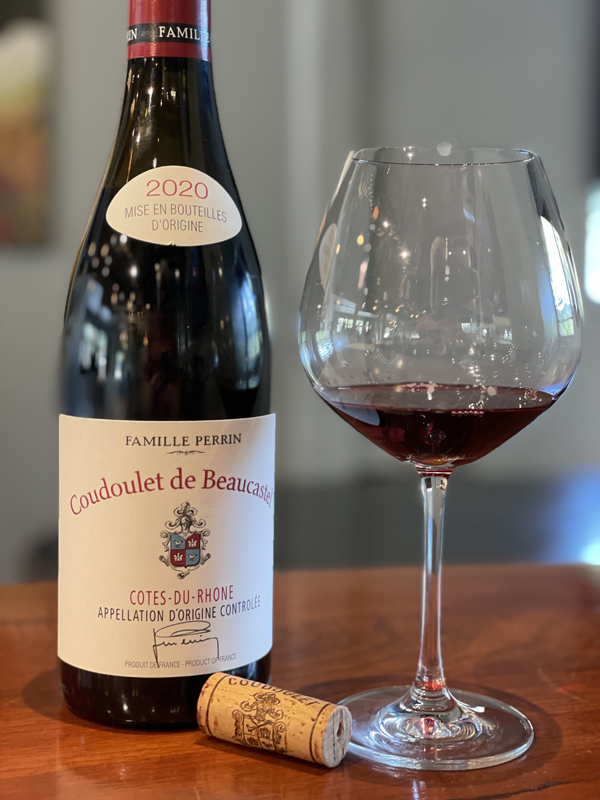2020 Coudoulet de Beaucastel – Famille Perrin, Cotes-du-Rhone Rouge, Southern Rhone Valley, France.
The beautifully purple/garnet 2020 Coudoulet de Beaucastel is still youthful and bright in the glass, but regal and opulent with lush black and red fruits leading the way on the medium to full bodied palate. This wine (is) made from about 40% Grenache, 20% to 30% Syrah, depending on the years best fruit, 20% Mourvedre and up to 20% Cinsault, again the vintage will dictate the amount here, with 2020 having the full 20%, which adds to this wine’s juicy vibrancy and moderate alcohol. There’s boysenberry, chocolate covered cherries, plum and some creme de cassis along with touches of crushed lilacs, anise, warm rock, camphor and grilled herbs. The Coudoulet Cotes-du-Rhone red has long been a wine I have admired for the value and substance found here, while the Perrin empire is large, so is Guigal, Jaboulet and Chapoutier, and they all make some sublime wines, with this Coudoulet being not far off Chateauneuf-du-Pape. It comes from the same terroir with an underpinning of Molasse seabed, of the Miocene period, covered by diluvial alpine deposits (rolled pebbles), or Galets, identical to the vineyards of Châteauneuf-du-Pape. The Coudoulet de Beaucastel is often considered the “Baby Beaucastel” and it is literary concurrent to their historic Châteauneuf property! When in 1936, Châteauneuf-du-Pape gained notoriety becoming the very first French appellation or official AOC, which was boon for the area around Avignon, or the new home of the Pope. It was a messy process to decide what vineyards were in the new formed zone with some winners and some losers and the existing vineyards at Beaucastel were divided up and the 75 acres of Coudoulet vineyards were strangely not part of the official Châteauneuf-du-Pape AOC in the end. Even though the vineyards are located just east of the vineyard of Beaucastel and that it terroir has its similarities, it became just a Cotes-du-Rhone, but a really really good one. With the Coudoulet Cotes-du-Rhone the winery employs a classic maceration and fermentation that occurs in cement tanks for 12 days, before seeing a gentle pressing, in pneumatic presses, after which the wine is blended from the different varietals after malolactic fermentation and aged in large, mainly used, oak Foudres for close to six months.
Château de Beaucastel’s history dates back to 1549, when Pierre de Beaucastel purchased the original estate vineyards and built a manor house or chateau as the name suggests. In 1909, by chance another Pierre, Pierre Traminer, the winery notes, purchased the property, which he later transferred to his son-in-law Pierre Perrin, who started the dynasty here in the region that continues today, where the fourth and fifth generation of Perrins run this famed wine estate. I have been lucky enough to have sit in on amazing vertical tastings with and without some of the Perrins, including a memorable event with Francois and many vintages of their Hommage Jacques Perrin Châteauneuf, which was one of my all time great tastings! Throughout the generations the (Perrin) family’s values have remained, with an absolute respect for land and terroir that led them to be pioneers into biodynamics and the pursuit of authenticity, balance, and elegance in their wines. Beginning with all organic farming in 1950 and then full biodynamic farming by 1974 even earlier than some of the greats of Burgundy. There is deep conviction, with the Perrins, that the grapes must have ripe and concentrated flavors to make an outstanding wine and much has changed in the cellars over time to reflect this, going away from the meaty, rustic and Bret affected wines of the eighties to a cleaner and more fruit driven style. Most of the difference between the top Château de Beaucastel Rouge and this Coudoulet de Baucastel bottlings is actually is down to the percentage of the main grapes, with Coudoulet having more of an even mix of varietals, while its big brother Beaucastel has always had a Mourvedre focus, even though it always has some amount of all the13 classified grapes, like Vieux Telegraphe, and unlike the Grenache focused Rayas and Pegau, as well as having much more Cinsault in the final blend, which makes it more easy and fresh than the top wines at Beaucastel. The Coudoulet de Beaucastel Cotes-du-Rhone Rouge is a great way to enjoy the best of Châteauneuf, without paying the much higher price of the classified versions and I highly recommend it for Rhone enthusiasts on a budget, who want the best bang for the buck they can find.
($32 Est.) 92 Points, grapelive
